|
 Secure Site
Secure Site
|
 |
Archive for the 'Chime Alarm Clocks' Category
Kyoto meets Giverny in this artful garden, a sublime space for contemplation.
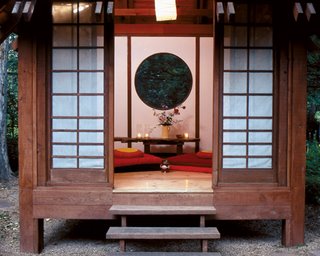 teahouse, photo by Povy Kendal Atchison Japanese shoji screens traditionally are made from translucent rice paper, but the owners chose a durable, light-penetrating fabric that will prevail in harsh weather. It allows filtered light without sacrificing privacy. The floor is salvaged pine planks from a park ranger’s mountain cabin, and a round window brings in the garden even when the doors are closed.
Ten years ago, a Boulder, Colorado, couple bought a house on a patch of grass with some overgrown shrubs, sliced by an irrigation ditch. Where many people might have seen desolation, these intrepid gardeners saw the opportunity to create a private world of solitude and renewal. In the process, they discovered that designing and planting is as soothing as enjoying the completed garden.
The contemplative garden they’ve created gently nods to Asian style while embracing European impressionism. It borrows from 19th-century impressionist painter Claude Monet, as well as from the Japanese love of plant textures, weeping trees and artfully placed rocks. It includes water, rocks, expanses of greenery and winding paths, but not the formal Japanese plantings that require so much upkeep.
Monet’s famous garden in Giverny, France, includes a Japanese bridge over a water lily pond. In this Colorado garden, a pale-aqua bridge arches over an irrigation ditch that’s been funneling water to farmers for 100 years. Just as the lily pad pond became the Monet garden’s major draw, the ditch has been transformed—lined with sandstone rocks alongside a bed of river rocks. Gold, yellow and orange daylilies drape the bank, blooming in midsummer when the Siberian and Japanese irises offer only seed pods. Ornamental grasses bend and sway to the breeze stirred up by the water’s flow. The ditch is an enticement; visitors brace against the railing and peer into the water, watching blossoms float downstream.
Every corner of this garden was designed with careful thought, not lavish funds. A decade of hard work and trial-and-error provided an education.
Piecing together elegance
Every corner of this garden was designed with careful thought, not lavish funds. A decade of hard work and trial-and-error provided an education. In hindsight, the homeowners believe their decision to tackle their garden in small pieces rather than taking on the entire half-acre saved them time, money and frustration.
“We didn’t have a grand master plan,” one of the homeowners admits. Instead, he started by clearing dead and dying trees. Then he parceled the property into smaller gardens: a ditch lined with water-loving plants and flagstones circles the edges of the gardens and is sprinkled with elfin thyme and other herbs for groundcover.
To imitate nature’s undulating, uneven landscape, he built mounds, or berms, from garden soil, adding interest to the flat piece of land. Berms also provide quick drainage for plants that might never take hold without humus and gravel. Sun-loving plants such as foxtail lilies and peonies are located on the sunny mounds. Shade-loving hostas line the flagstone walkways under giant locust trees.
“It all came together like a jigsaw puzzle,” the gardener says, with groundcovers of thyme and vinca, creeping veronica, wild strawberries and sweet woodruff. Groundcovers that can become invasive thugs, such as the sweet woodruff, were banished to the riverbank under the house, where it can duke it out with ornamental strawberries for space and light.
What’s in this garden?
• Crabapple trees (Malus spp), highly adaptable to most weather and soil conditions, have exquisite spring blooms. The weeping varieties include Red Jade, Coral Cascade, White Cascade and Louisa. Best to order from your local garden center.
• Species (or wild) tulips (Tulipa spp) have brilliant hues and hardiness. Long before more formal tulips became the backbone of Dutch gardens, miniature species tulips blanketed hillsides in Turkey. Most only can be grown in climates with winter temperatures. Order from trustworthy companies (see “Resources,” below) that propagate their own bulbs and do not harvest from the wild.
• Foxtail lilies (Eremurus spp) have attention-grabbing feathery spikes and day-glow colors. They’re easy to grow, but they do require good drainage to avoid root rot.
• Thyme (Thymus spp) may be slow to start, but once established, it tolerates some foot traffic. Best as filler between stepping stones, aromatic thymes will creep around rocks and steps, choking out weeds.
• Daylilies (Hemerocallis spp) have sweeping, grasslike foliage and arching blooms. Each blossom lasts only one day, but the plant blooms nonstop throughout summer. They require little care aside from division every few years, and only a moderate amount of water.
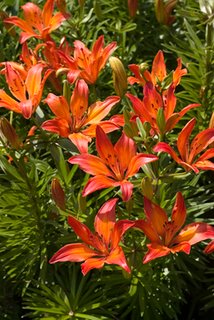 daylilies • Irises (Iris spp) are easy to grow if you choose the right cultivars for your garden. Siberian and Japanese irises grow best in moist, slightly acid soil, perhaps on the banks of a pond or stream. For alkaline soil and aridity, choose bearded irises. And if you love variegated leaves of white and green, look into Iris pallida.
• Hostas (Funkia spp), with wide, variegated leaves, add to foliage interest rather than floral displays. Lords of the shade garden, hostas can be found in a variety of sizes, some with blue-tinged or gold coloration and heart-shape leaves. All need some moisture and dappled shade.
Four seasons of splendor
In this garden, bold plants such as peonies and foxtail lilies are the prima donnas—showy and extravagant with heavy blooms. Other beauties are far smaller and require a closer look. Brilliant red and yellow species tulips—more natural looking than their formal, hybrid cousins—pop up among drifts of thyme. Delphiniums and their smaller brethren, larkspur, join foxgloves for height and extravagant color. Oriental poppies and California poppies display papery petals, popping up in mounds and drifts.
 oriental poppy In early spring, the bright blues and purples of the groundcovers cluster throughout the garden, complementing the species tulips’ tiny blooms. By late spring, foxgloves and Siberian and Japanese irises dominate. Summer is golden, as daylilies offer orange, yellow and cream colors.
The garden may be at its best in winter, the gardeners claim. Japanese lanterns guide visitors down the flagstone footpath, and snow sets a black-and-white scene. Bare, weeping crabapple branches bend gracefully like sculpture. “Some of the most beautiful times in the garden are in the snow,” the homeowner says. “You see all the shapes that don’t go away: the mounds, rocks, ornaments, trellises.”
Reflecting in the teahouse
Autumn and winter usher in the garden’s quiet moments, when trowels are put away. A tiny teahouse, built of salvaged cedar siding left over after the house was built, holds sway. Once inside, a cup of hot tea banishes the cold. Sliding shoji screen doors open to the sparkling light on snow or close to keep out a brisk wind. The nine-by-nine-foot teahouse anchors this garden, a reminder that its primary purpose is to promote meditation and reflection rather than busyness. A Zen Timepiece adornes the interior so that one can timer their meditation practice. The naked branches of an old cottonwood tree loom over the teahouse while smaller pines and dwarf evergreens screen the street and neighborhood. “The teahouse gave us a focus for the garden,” the homeowner says, “and cut down the amount of lawn.”
In winter’s stillness, when birds are silent, only the bamboo wind chimes clink softly. The teahouse’s back wall features a round window that provides the most private views and connects the garden to the teahouse. “I wanted a big round window,” the owner says, “to bring the outside in.”
 Zen Timepiece with brass singing bowl, a meditation timer. adapted from Natural Home Magazine, March/April 2008 by Niki Hayden
Now & Zen
1638 Pearl Street
Boulder, CO 80302
(800) 779-6383
Posted in Bamboo Chime Clocks, Chime Alarm Clocks, Japanese Inspired Zen Clocks, Now & Zen Alarm Clocks, teahouse, Well-being, Zen Timepiece by Now & Zen, Zen Timers
 yoga, loosen up pose Saturday: Loosen Up
The sun’s out and the day’s wide open. Savor your Saturday by twisting away any residual tension in your back. It’s a delicious way to wake up — or even wind down after running around town.
Supported Reclined Twist
What It Does
Helps the whole body (hips, spine, digestive system, nervous system, shoulders, chest, etc.) unwind. Promotes digestion and detoxification.
How to Do It
Set your Zen Yoga Timer to gong after 5 minutes. Lie on your back, dropping your left knee across your body to rest on a pillow or blanket. Shift your hips right to avoid over-twisting the lower back.
Rest your arms, elbows soft, on the floor over your head. Turn your head in whichever direction feels most comfortable and breathe into this gentle stretch for 5 minutes on each side, until the gong chimes.
adapted from Body + Soul, 2010
 Zen Yoga Timepiece in Maple Now & Zen
1638 Pearl Street
Boulder, CO 80302
(800) 779-6383
Posted in Chime Alarm Clocks, Japanese Inspired Zen Clocks, Well-being, Yoga Timer, Yoga Timers by Now & Zen, Zen Timepiece by Now & Zen, Zen Timers
 yoga, sooth frazzled nerves pose Friday: Soothe Frazzled Nerves
As another hectic workweek slows to a close, it’s time to downshift — and ramp up your self-care.
Friday’s pose quiets your mind and nervous system, restoring your inner resources so that you can fully enjoy the weekend ahead.
Supported Child’s Pose
What It Does
Releases the muscles in the back, gently opens the hips, boosts your energy.
How to Do It
Set your Zen Timepiece to gong after 5 minutes. Sit back on your heels with your legs folded under you and the tops of your feet on the floor. Open the knees wide and bend forward at the hips.
Rest your forehead (or your chest) on a pillow or blanket and keep your arms slightly bent. If your buttocks don’t reach your heels, place a blanket under your thighs. Relax and breathe deeply for 5 minutes, until your Zen Yoga Timer gongs.
adapted from Body + Soul, 2010
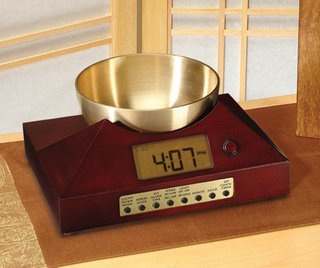 Zen Timepiece with brass singing bowl, a yoga timer
Now & Zen
1638 Pearl Street
Boulder, CO 80302
(800) 779-6383
Posted in Bamboo Chime Clocks, Chime Alarm Clocks, Japanese Inspired Zen Clocks, Meditation Timers, Meditation Tools, Now & Zen Alarm Clocks, Well-being, Yoga Timer, Yoga Timers by Now & Zen, Zen Timepiece by Now & Zen, Zen Timers
 exhaustion cures - setting your Zen Alarm Clock Are you feeling stressed, fatigued, and burned out? Discover the top 10 ways to put a stopper in your personal energy drains
Consider this simple question: How are you?
We answer it 10 times a day, often rejoining with a clipped “Fine” or “Busy!” accompanied by a glazed smile. But when your best friend or spouse asks, perhaps you tell the deeper truth: You’re stressed out and tired. Really tired.
“Busy,” “stressed,” and “tired” are intimately connected. They describe the ethos of our times — and its inevitable aftermath. We balance work, family, friends, and our various self-improvement programs. We take in a steady stream of information from the people, screens, phones, and sounds that surround us. We don’t sleep enough. We multitask like crazy, striving to get more done in less time.
For a while, maybe even years, it’s easy to feel like you can handle this frantic pace — or even thrive at it. But ultimately, it works against you. “Stress is pervasive in our society, and it’s only getting worse,” says integrative-medicine expert Woodson Merrell, M.D., author of “The Source: Unleash Your Natural Energy, Power Up Your Health, and Feel 10 Years Younger.” “And people do not necessarily have the coping skills to deal with it, even when they think they do.” We often don’t realize how much of our days are spent dealing with stressful situations, and on a physiological level, the effects of stress add up. “You don’t start every day with a clean slate,” he says. “You start the day with all the stress you’ve accumulated in your life, and you add to that.”
No wonder we’re so tired. In fact, many experts contend that chronic stress and our inability to cope with it are the biggest factors in fatigue. “I hear it all the time. People tell me, ‘I have no energy, I can’t sleep, I’m exhausted,'” says Andrew Weil, M.D., director of the Arizona Center for Integrative Medicine at the University of Arizona and author of “Healthy Aging.”
This “tired-wired” state has become a cultural condition, he adds. And for those that struggle with it, fatigue can also become a significant crisis. “Your personal energy level should meet the demands of the day. Your sense of well-being should be good most of the time,” says Weil. “When it’s not, you have a real quality-of-life shortage.”
As is always the case, however, in crisis lies opportunity. Fatigue, it turns out, can be a terrific teacher, giving you a chance to slow down and examine your life, learn more about yourself, and consider what’s really important.
For starters, you want to cover your bases by eating a healthy diet, getting regular exercise, maintaining good sleep habits, and following other steps toward sound overall energy hygiene. But many of our most potent energy drains fly under the radar. By taking careful stock of your daily habits, work life, and relationships, you can begin to see patterns that cause your vitality to slip away unnoticed; make some simple changes, and you’ll plug these leaks and start feeling better. Choosing a gentle, chiming Alarm Clock to awaken you in the morning could be step 1.
 Japanese Leaves Dial Face in Burgundy Finish by Now & Zen Here, Merrell, Weil, and other experts highlight 10 surprising causes of fatigue and offer thought-provoking solutions to help you energize your mind, body, and spirit — and your life.
1. Exhaustion Cause: Good News
We know that our energy gets drained by negative events: death of a spouse, divorce, imprisonment, getting fired, serious illness or injury, losing your home or savings. But positive events can drain us, too, says Alice Domar, Ph.D., executive director of the Domar Center for Mind/Body Health in Waltham, Massachusetts. “Getting married, having a baby, buying a new house, getting promoted at work — these are all positive steps, but they often come with a lot of worry, which can be exhausting.”
To further complicate the picture, it’s hard to find support when things are going great. “Tell people you’re exhausted because you’re caring for your dying mother, and you’ll get all the support in the world,” Domar says. “Tell them you’re exhausted because you got a fantastic new job, and they’ll be like, ‘Give me a break!’ ”
Exhaustion Cure: Make a Positive Prep Plan
The best way to end-run positive exhaustion? Prepare for it. “When you start getting tired,” says Domar, “ask yourself two questions: ‘What’s being asked of me that I don’t feel that I can deliver?’ and ‘Am I accurately perceiving what’s needed?'” Then make a list of what really needs to be done, and when. “We often feel like everything needs to happen at once, and that’s not true,” says Domar. Breaking things down into manageable chunks lets you catch your breath so you can plan and delegate accordingly.
adapted from Body + Soul, September 2009
 Digital Zen Alarm Clocks, available in maple, walnut, bamboo, and black lacquer
Now & Zen
1638 Pearl Street
Boulder, CO 80302
(800) 779-6383
Posted in Bamboo Chime Clocks, Chime Alarm Clocks, Japanese Inspired Zen Clocks, Natural Awakening, Now & Zen Alarm Clocks, Sleep Habits
 ink painting Fast knowledge is about solving problems, slow knowledge is about preventing them.
Knowledge is being applied faster and on a larger scale than ever before – with consequences that are sometimes disastrous. Farmers can use the latest chemical pesticides to protect their crops, but the pests soon develop resistance to these new substances. This is an example of the failings of “fast knowledge”, according to environmental philosopher David Orr. Truly valuable knowledge is developed through a lengthy process of trial and error, he believes, and not by racing ahead with some new but untested innovation.
As a rule, fast knowledge – standardized, measurable solutions – is seen as the pinnacle of human progress. But many of society’s current problems can be traced to the fact that we apply knowledge before we took the time to consider the consequences. The speed at which we are confronted with new technologies – in communication, agriculture, health, energy, etc. – and with growing mountains of information in all fields, far exceeds the human ability to absorb and learn from it.
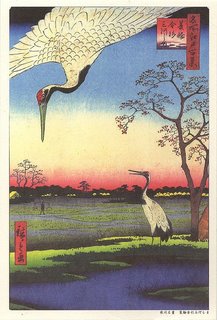 Utagawa Hiroshige (1797-1858) Cranes in a Landscape Ukiyo-e Orr, who teaches environmental studies at Oberlin College in Ohio, has begun championing what he calls slow knowledge, whose main themes are thoroughness, patience and harmony. In The Nature of Design: Ecology, Culture, and Human Intention (Oxford Press, 2002) Orr describes slow knowledge as resilient, elegant and, most of all, practical. Fast knowledge, meanwhile, is usually hierarchical, abstract, and based upon a sense of competition. Laboratories, universities and boardrooms are the places where fast knowledge is usually created out of reams of new data. Slow knowledge often arises from the wisdom of local communities.
adapted from Ode Magazine, July 2004 by Marco Visscher
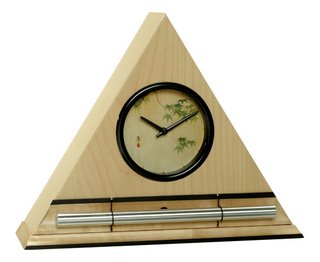 Zen Alarm Clock in Maple Finish, Japanese Leaves Dial Face, harmony in design
Now & Zen
1638 Pearl Street
Boulder, CO 80302
Posted in Bamboo Chime Clocks, Chime Alarm Clocks, intention, Japanese Inspired Zen Clocks
 plum blossoms with moon The power of intention can be used to heal and promote good health, improve performance in many areas and even affect the future.
To be most effective, an intention should be a highly specific aim or goal, which you should visualize in your mind’s eye as having already occurred, while you are in a state of concentrated focus and hyper-awareness. When you imagine this future event, hold a mental picture of it as if it were occurring to you at that moment. Engage all five senses to visualize it in detail.
The centerpiece of this mental picture should be the moment you achieve the goal.
We might also improve the quality of our daily lives just by carrying out detailed mental rehearsals. At home, we might be able to send intentions to our children to perform better at school or to allow us to be more loving to friends and family. Human intention might be powerful enough to affect every element of our lives.
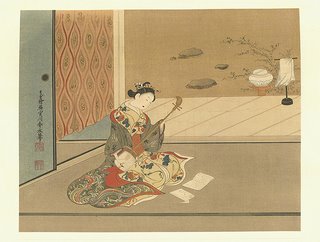 Shunsui Katsu-Miyagawa All of these possibilities suggest that we have an awesome level of responsibility when generating our thoughts. Each of us is a potential Frankenstein, with extraordinary power to affect the living world around us. How many of us, after all, are sending out mostly positive thoughts?
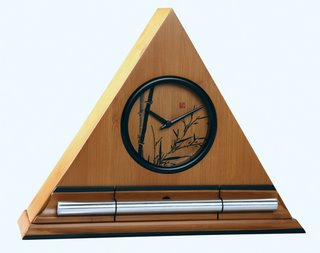 Bamboo Zen Clocks, progressive chime clock and timer
Adapted from Ode Magazine, Jan/Feb 2007 by Lynne McTaggart (The Intention Experiment: Using Your Thoughts to Change Your Life and the World, Free Press 2007)
Now & Zen
1638 Pearl Street
Boulder, CO 80302
Posted in Bamboo Chime Clocks, Chime Alarm Clocks, Goodness, intention, Japanese Inspired Zen Clocks, Meditation Timers, Meditation Tools, mindfulness practice, Natural Awakening, Now & Zen Alarm Clocks
 Kasamori Osen Ippitsusai Buncho SleepwalkingWhat causes it?
Sleepwalking is most common in children, who usually grow out of it. It’s a psychological issue, and when it continues into adulthood there’s typically two factors involved. “There tends to be some sort of hereditary component – it runs in families to some extent. And for people who are more susceptible to sleepwalking, times of stress bring it on,” says Professor Jim Horne, Director of the Sleep Research Centre at Loughborough University.
 Zen Alarm Clock How to beat it
When sleepwalking, nobody talks – they just babble incoherently. But in order to stifle your somnambulism, a long chat is the best medicine. “Try to get at the underlying cause,” says Horne. “It’s a simple case of talking to someone close to you about what’s on your mind. Just be matter-of-fact about it and take it from there.” Still find yourself stalking the corridors by night? A ccording to a study in the Annals of Neurology, sleep deprivation significantly increases the number of sleepwalking episodes experienced by predisposed individuals. Staying up past midnight stopped being cool long ago. Get your eight hours in.
adapted from Men’s Health, Ed Vanstone
Posted in Chime Alarm Clocks, Japanese Inspired Zen Clocks, Meditation Timers, Natural Awakening, Now & Zen Alarm Clocks, Sleep Habits
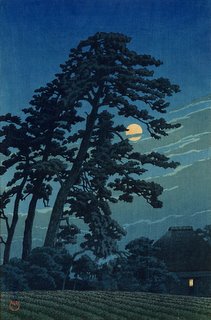 moonviewing, sweet slumber We spend up to a third of our lives asleep. Although some hard-driving people may view sleep as an inconvenience that curtails productivity and leisure activities, slumber is certainly no waste of time. In fact, sleep may play a more crucial role than diet or exercise in fostering optimal health.
A natural restorative, sleep offers an antidote to the damage done to our bodies during the day. It allows the body to replenish its immune system, eliminate free radicals, and ward off heart disease and mood imbalances. When sleep is disrupted—whether by lifestyle factors, insomnia, sleep apnea, narcolepsy, restless legs syndrome, jet lag, sleepwalking, night terrors, imbalance of hormones, or some other disorder—emotional and physiological health suffers. But you don’t have to accept sleep deprivation and the ills that accompany it. One way to gently snooze your way back to health is to focus on balancing your hormones.
Balance your hormones
The word hormone comes from the Greek hormon, meaning “to stir up.” Hormones are released by the various endocrine glands in the body in order to regulate energy production, growth, sexual development, stress responses, and many other functions. Because minute quantities of hormones can “stir up” so many activities in the body, when they are thrown out of balance the results can affect the entire body. Imbalances of Hormones often manifest as insomnia and other sleep problems. Key factors that can upset hormone levels include thyroid dysfunctions, perimenopause and menopause (in fact, disturbed sleep is one of the complaints that cause women to seek treatment for menopause and perimenopause), and andropause (the male form of menopause). Although hormone levels generally decline as a result of aging, they can also be affected by dietary choices, mineral deficiencies, environmental toxins and synthetic chemicals, medications, smoking, and stress.
Rather than artificially manipulating your estrogen levels with synthetic hormones and ignoring the reasons behind any imbalances of hormones, it is more valuable to determine why you have imbalances of hormones in the first place. Depending on the reason, restoring hormonal balance may be more effectively achieved with dietary changes, nutritional supplements, natural progesterone cream, herbal therapy, or traditional Chinese medicine tailored to the specific factors causing the imbalance of hormones.
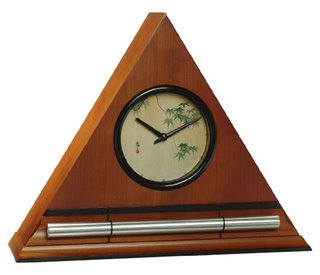 Zen Clock with Chime for a progressive awakening to sweet a slumber Now & Zen
1638 Pearl Street
Boulder, CO 80302
Excerpted from Alternative Medicine magazine’s Definitive Guide to Sleep Disorders: 7 Smart Ways to Help You Get a Good Night’s Rest (Celestial Arts, 2007)
Posted in Bamboo Chime Clocks, Chime Alarm Clocks, Japanese Inspired Zen Clocks, mindfulness practice, Natural Awakening, Now & Zen Alarm Clocks, Sleep Habits
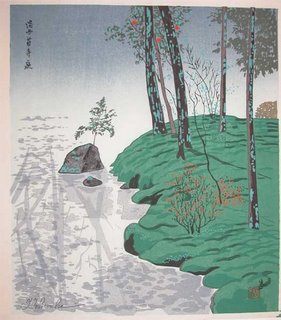 Garden of Kokedera Temple, Kyoto 1980, Tokuriki Almost everyone has a cherished memory of sleeping outdoors. A roof of stars, a cricket lullaby, the cool air on your face, awakening to the calls of birds and the first rays of the sun. It’s a welcome relief from the confines of a square room, stale indoor smells, and noisy appliances.
One particular outdoor sleeping experience made me a believer. A friend and I were camping in late summer at the edge of a meadow in an oak woodland. We kept it simple: sleeping bags rolled out on a tarp. The first night I remember thinking, Is nature always this noisy? How am I supposed to sleep? To my city-numbed senses, it was all new: the low moan of the wind in the tree branches, the crunching footfall of small animals on dried leaves, the hoot of owls, the distant howl of coyotes. And that moon—won’t somebody turn out the light?
But by the second night, the living world had woven me into its tapestry. I fell asleep easily, held by the earth, stroked by sweet breezes, reassured by the rustling of life all around me. When we broke camp a few days later, I felt like I was being torn from maternal arms. All my cells, newly accustomed to a deep sense of homecoming, told me that something precious was being left behind.
We were made for this stuff. Our ancestors were sleeping outdoors long before there were doors to sleep out of. Our senses, our psyches, our biological clocks are attuned to the rhythms of the sun and moon and the sounds, smells, and feel of the living web. When we sleep, we renew ourselves; there is no more important time to breathe clean, cool air and hear the thrumming of nature.
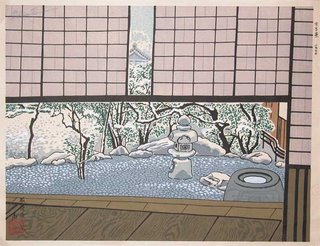 Teahouse at Daitokuji Temple, Kyoto by Tokuriki, 1977 Try this at home
If you need a breath of fresh air tonight, you can start inexpensively: Pitch a tent in the yard or pull your bed onto the deck in fair weather. I f you enjoy the experience, you may want to build a permanent sleeping porch or pavilion with a table for your portable Bamboo Zen Alarm Clock. Or you can alter an existing room to open up when the weather is pleasant; a wall of windows or doors that move aside can bring the outdoors to you.
adapted from Natural Home, July/August 2002 by Carol Venolia
 Zen Alarm Clock, Ukiyo-e Hokusai Wave Dial Face Now & Zen
1638 Pearl Street
Boulder, CO 80302
Posted in Chime Alarm Clocks, Japanese Inspired Zen Clocks, Now & Zen Alarm Clocks, Progressive Awakening, teahouse
 A shakuhachi flute, traditionally made of bamboo The shakuhachi, is a Japanese end-blown flute. It is traditionally made of bamboo, but versions now exist hardwoods. It was used by the monks of the Fuke of Zen Buddhism in the practice of suizen, blowing meditation).
Suizen is a Zen practice consisting of playing the shakuhachi bamboo flute as a means of attaining self-realization. The monks from the Fuke sect of Zen who practiced suizen were called komusō (“emptiness monks”).
adapted from wikipedia.org
 B Tone Digital Zen Alarm Clock in a Bamboo Finish
Now & Zen
1638 Pearl Street
Boulder, CO 80302
Posted in Bamboo Chime Clocks, Chime Alarm Clocks, Japanese Inspired Zen Clocks, Now & Zen Alarm Clocks, Progressive Awakening, zen monks, Zen Timers
« Previous Page — « Previous Entries
Next Entries » — Next Page »
|
|
|
|